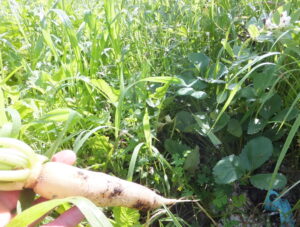Who doesn’t desire bigger, more beautiful plants in their yard and garden? The dirt under our feet provides the essential basics to all life. Yet, many of the things that are done in an attempt to achieve better growth of crops, landscapes, gardens and lawns is detrimental to soil health. If we care for the soil, we achieve more than just healthier growth of plants.
Regeneration of soil yields environmental rewards. Better management of the soil resource results in less soil erosion, better absorption of precipitation, greater carbon capture, increase of beneficial organisms, reduction in plant diseases and fewer opportunities for invasive species. But why do we need to do this now?
Historic clear cutting and burning, followed by extractive farming and uncontrolled grazing impacted nearly every acre in Wisconsin. These actions have been repeated where ever people live to make it almost impossible to find truly native soil with full functionality anywhere. In many, but not all cases, farming today exploits the soil as simply a matrix to grow crops essentially through hydroponics, adding massive amounts of fertilizer and water with the prerequisite pesticides. Unfortunately, some of our home gardening and landscaping activities follow a similar destructive pattern.
Our suburban and urban soils can mostly be described as confused and abused. Construction of roads, building of homes, placement of businesses and installation of parking lots has caused soils to be moved, mixed and compacted. Adding conventional fertilizers, pesticides and other chemicals to these dysfunctional soils in an attempt to re-mediate plant growth problems is a short term fix. It is necessary to rehabilitate the soil to restore it.
You don’t need to go to the expense of completely removing poor quality soils and replacing with better soil. Soil improvement can be achieved many different ways and does not need to be done all at once. Here are some of the actions that produce better soil:
-

Daikon radish that can produce a root more than a foot deep in the ground improves physical and nutrient soil conditions as a temporary cover crop.
Grow almost anything! Plants support soil organisms, roots grow and die adding organic mater, roots and stems hold soil in place and plants provide a natural layer of insulation for the winter months.
- Use mulches to add organic material. Any organic material that breaks down will add beneficial organic material to the soil, slow run-off, reduce compaction and support symbiotic mycorrhiza.
- Plant a cover crop. A short term planting in the yard or garden that is then tilled in can produce dramatic results in adding organic matter and nutrients to your soil. There are many cover crop choices that include grains, legumes and broadleaf plants.
- Use compost as fertilizer. Compost can even be spread as a thin layer, called top dressing, on lawn surfaces to achieve improved growth and soil conditions. Chemical fertilizers do not add much needed organic materials to your soil; compost does.
- Reject the use of landscape fabrics. These fabrics interrupt the relationships of surface organic materials to soil organisms. Landscape fabrics also create problems in long-term maintenance as mulches break down and plants become shallow rooted.
Transformation of soil is always part of the basis for multiple benefits produced in every action in a sustainable landscape. If you would like to know more about your soil, contact me by filling out the form below:
